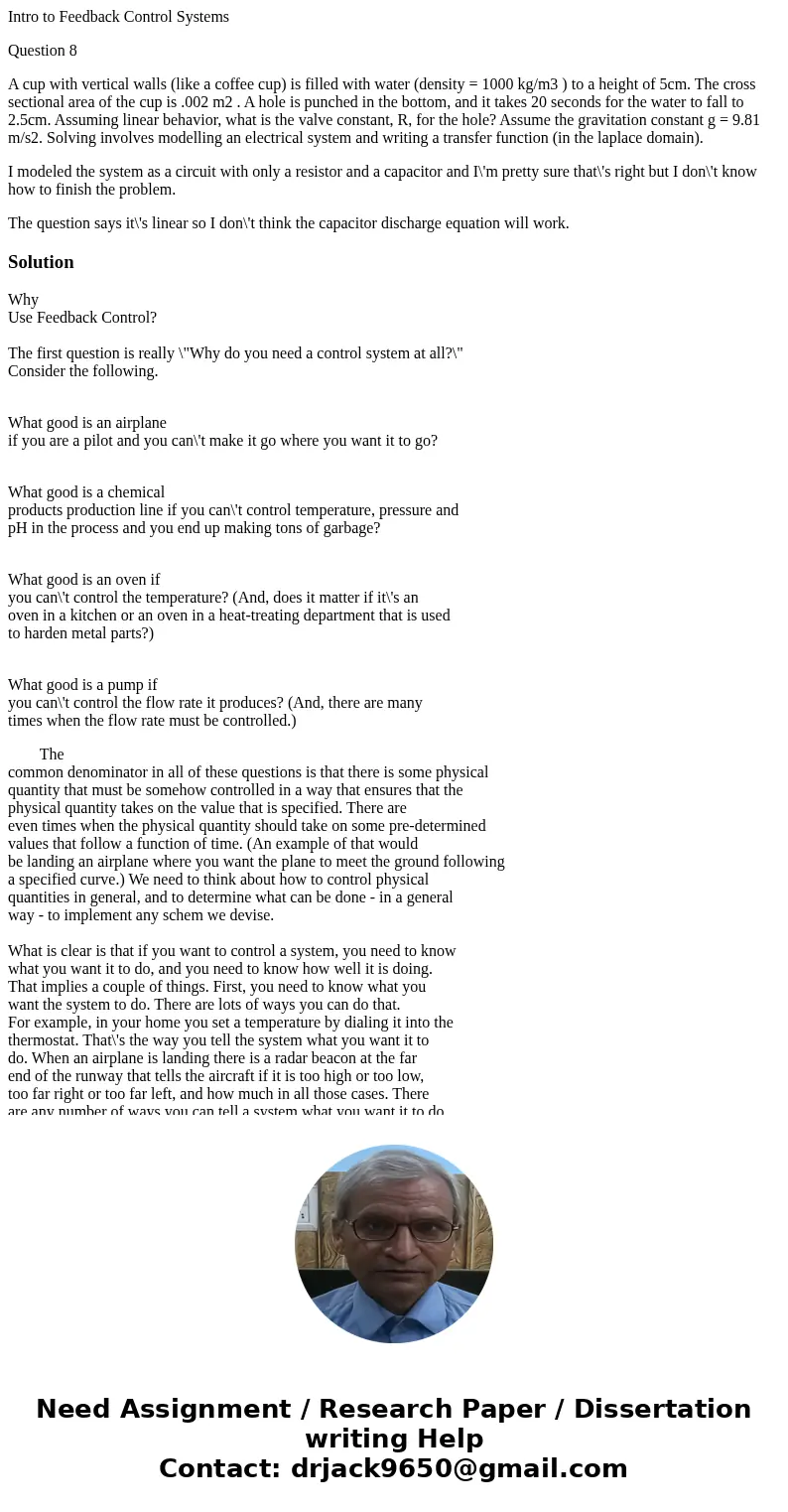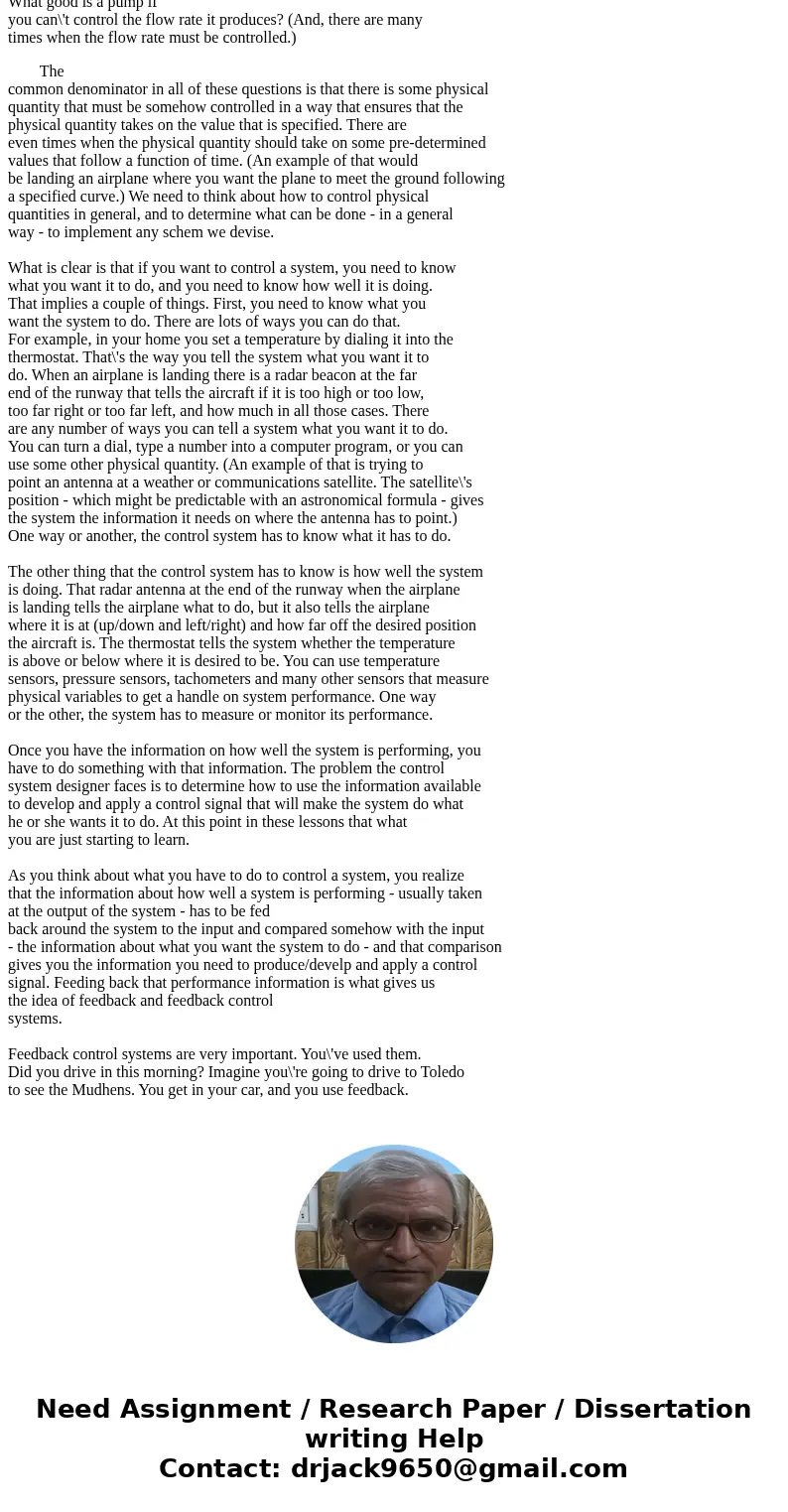Intro to Feedback Control Systems Question 8 A cup with vert
Intro to Feedback Control Systems
Question 8
A cup with vertical walls (like a coffee cup) is filled with water (density = 1000 kg/m3 ) to a height of 5cm. The cross sectional area of the cup is .002 m2 . A hole is punched in the bottom, and it takes 20 seconds for the water to fall to 2.5cm. Assuming linear behavior, what is the valve constant, R, for the hole? Assume the gravitation constant g = 9.81 m/s2. Solving involves modelling an electrical system and writing a transfer function (in the laplace domain).
I modeled the system as a circuit with only a resistor and a capacitor and I\'m pretty sure that\'s right but I don\'t know how to finish the problem.
The question says it\'s linear so I don\'t think the capacitor discharge equation will work.
Solution
Why
Use Feedback Control?
The first question is really \"Why do you need a control system at all?\"
Consider the following.
What good is an airplane
if you are a pilot and you can\'t make it go where you want it to go?
What good is a chemical
products production line if you can\'t control temperature, pressure and
pH in the process and you end up making tons of garbage?
What good is an oven if
you can\'t control the temperature? (And, does it matter if it\'s an
oven in a kitchen or an oven in a heat-treating department that is used
to harden metal parts?)
What good is a pump if
you can\'t control the flow rate it produces? (And, there are many
times when the flow rate must be controlled.)
The
common denominator in all of these questions is that there is some physical
quantity that must be somehow controlled in a way that ensures that the
physical quantity takes on the value that is specified. There are
even times when the physical quantity should take on some pre-determined
values that follow a function of time. (An example of that would
be landing an airplane where you want the plane to meet the ground following
a specified curve.) We need to think about how to control physical
quantities in general, and to determine what can be done - in a general
way - to implement any schem we devise.
What is clear is that if you want to control a system, you need to know
what you want it to do, and you need to know how well it is doing.
That implies a couple of things. First, you need to know what you
want the system to do. There are lots of ways you can do that.
For example, in your home you set a temperature by dialing it into the
thermostat. That\'s the way you tell the system what you want it to
do. When an airplane is landing there is a radar beacon at the far
end of the runway that tells the aircraft if it is too high or too low,
too far right or too far left, and how much in all those cases. There
are any number of ways you can tell a system what you want it to do.
You can turn a dial, type a number into a computer program, or you can
use some other physical quantity. (An example of that is trying to
point an antenna at a weather or communications satellite. The satellite\'s
position - which might be predictable with an astronomical formula - gives
the system the information it needs on where the antenna has to point.)
One way or another, the control system has to know what it has to do.
The other thing that the control system has to know is how well the system
is doing. That radar antenna at the end of the runway when the airplane
is landing tells the airplane what to do, but it also tells the airplane
where it is at (up/down and left/right) and how far off the desired position
the aircraft is. The thermostat tells the system whether the temperature
is above or below where it is desired to be. You can use temperature
sensors, pressure sensors, tachometers and many other sensors that measure
physical variables to get a handle on system performance. One way
or the other, the system has to measure or monitor its performance.
Once you have the information on how well the system is performing, you
have to do something with that information. The problem the control
system designer faces is to determine how to use the information available
to develop and apply a control signal that will make the system do what
he or she wants it to do. At this point in these lessons that what
you are just starting to learn.
As you think about what you have to do to control a system, you realize
that the information about how well a system is performing - usually taken
at the output of the system - has to be fed
back around the system to the input and compared somehow with the input
- the information about what you want the system to do - and that comparison
gives you the information you need to produce/develp and apply a control
signal. Feeding back that performance information is what gives us
the idea of feedback and feedback control
systems.
Feedback control systems are very important. You\'ve used them.
Did you drive in this morning? Imagine you\'re going to drive to Toledo
to see the Mudhens. You get in your car, and you use feedback.


 Homework Sourse
Homework Sourse